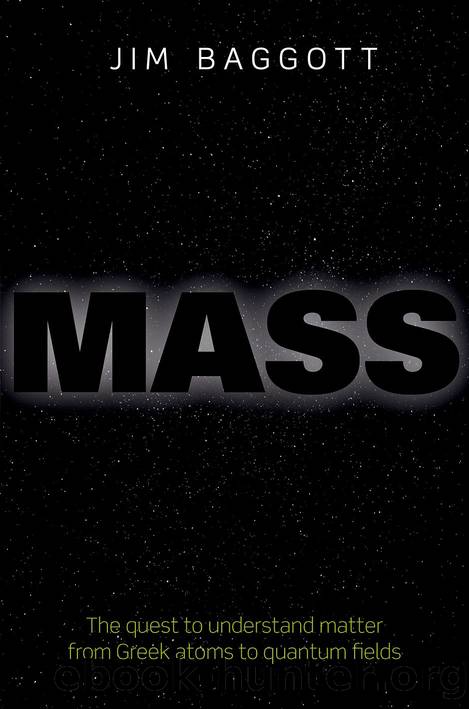Mass by Baggott Jim;

Author:Baggott, Jim; [Baggott, Jim]
Language: eng
Format: epub
Publisher: Oxford University Press, Incorporated
Published: 2017-04-20T00:00:00+00:00
The exchanged photon carries momentum from one electron to the other, thereby changing the momentum of both. The result is recoil, with both electrons changing speed and direction and moving apart.
The exchanged photon is a ‘virtual’ photon, because it is transmitted directly between the two electrons and we don’t actually see it pass from one to the other. According to this interpretation, the photon is no longer simply the quantum particle of light. It has become the ‘carrier’ of the electromagnetic force.
Now here’s a thing. Matter particles (such as protons, neutrons, and electrons) are all fermions, with half-integral spin quantum numbers (s = ½). Fermions obey Pauli’s exclusion principle. But the particles responsible for carrying forces between the matter particles are different. They are all bosons (named for Indian physicist Satyendra Nath Bose), characterized by integral spin quantum numbers. The photon, for example, has a spin quantum number s = 1.
Bosons are not subject to Pauli’s exclusion principle: they can possess the same quantum numbers and can ‘condense’ into a single quantum state. An example of such ‘bose condensation’ is laser light. It is impossible to achieve similar condensation with a beam of electrons—to produce an ‘electron laser’. Pauli’s exclusion principle forbids this.
Despite the attractions of QED and this explanation in terms of matter and force particles, no progress could be made until the problems of quantum field theory were resolved. Over the next fifteen years or so—interrupted by the turmoil of world war and the development of atomic weapons—the theory spilled into crisis.
A faint light at the end of the long dark tunnel of incomprehension was eventually spied in early June 1947, at a small, invitation-only conference held at the Ram’s Head Inn, a small clapboard hotel and inn on thinly populated Shelter Island, at the eastern end of New York’s Long Island. At this conference, leading theorists heard details of two experiments which, at first sight, seemed only to make things worse.
Columbia University physicist Willis Lamb, a former student of J. Robert Oppenheimer (the ‘father’ of the atom bomb) reported on some disturbing new results on the spectrum of the hydrogen atom. He had focused on the behaviour of two energy levels which share the same principal quantum number n = 2, but possess values of the azimuthal quantum number, l, of 0 and 1. These correspond to electron orbitals with different shapes. Orbitals with l = 0 form spheres around the central nucleus. Orbitals with l = 1 form lobes pointing in opposite directions shaped rather like dumbbells.
In Dirac’s relativistic quantum theory, the energies of these different orbitals is determined only by the value of n (as it was in Bohr’s theory and Schrödinger’s wave mechanics). Despite their different shapes, in the absence of an external electric or magnetic field these orbitals were expected to have precisely the same energy, producing a single line in the atomic spectrum.
But, working with graduate student Robert Retherford, Lamb had found that there are in fact two lines. One of the
Download
This site does not store any files on its server. We only index and link to content provided by other sites. Please contact the content providers to delete copyright contents if any and email us, we'll remove relevant links or contents immediately.
The Complete Stick Figure Physics Tutorials by Allen Sarah(6638)
Secrets of Antigravity Propulsion: Tesla, UFOs, and Classified Aerospace Technology by Ph.D. Paul A. Laviolette(3450)
Thing Explainer by Randall Munroe(3328)
The River of Consciousness by Oliver Sacks(2992)
The Order of Time by Carlo Rovelli(2714)
I Live in the Future & Here's How It Works by Nick Bilton(2524)
How To by Randall Munroe(2475)
A Brief History of Time by Stephen Hawking(2473)
The Great Unknown by Marcus du Sautoy(2186)
What If?: Serious Scientific Answers to Absurd Hypothetical Questions by Randall Munroe(2170)
Blockchain: Ultimate Step By Step Guide To Understanding Blockchain Technology, Bitcoin Creation, and the future of Money (Novice to Expert) by Keizer Söze(2137)
Midnight in Chernobyl by Adam Higginbotham(2078)
Networks: An Introduction by Newman Mark(1998)
The Meaning of it All by Richard Feynman(1909)
Easy Electronics by Charles Platt(1864)
The Tao of Physics by Fritjof Capra(1850)
When by Daniel H Pink(1777)
Midnight in Chernobyl: The Untold Story of the World's Greatest Nuclear Disaster by Adam Higginbotham(1775)
Introducing Relativity by Bruce Bassett(1754)
